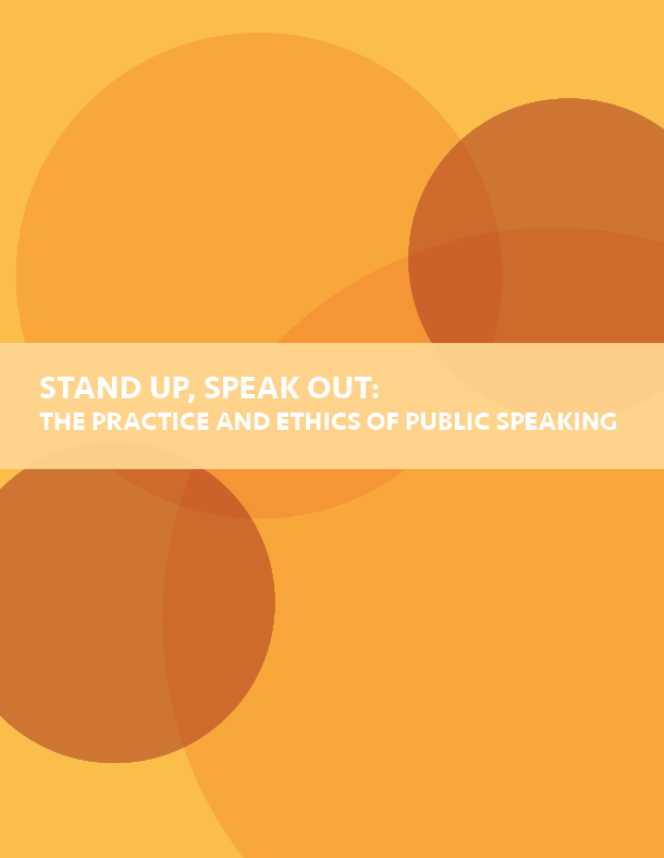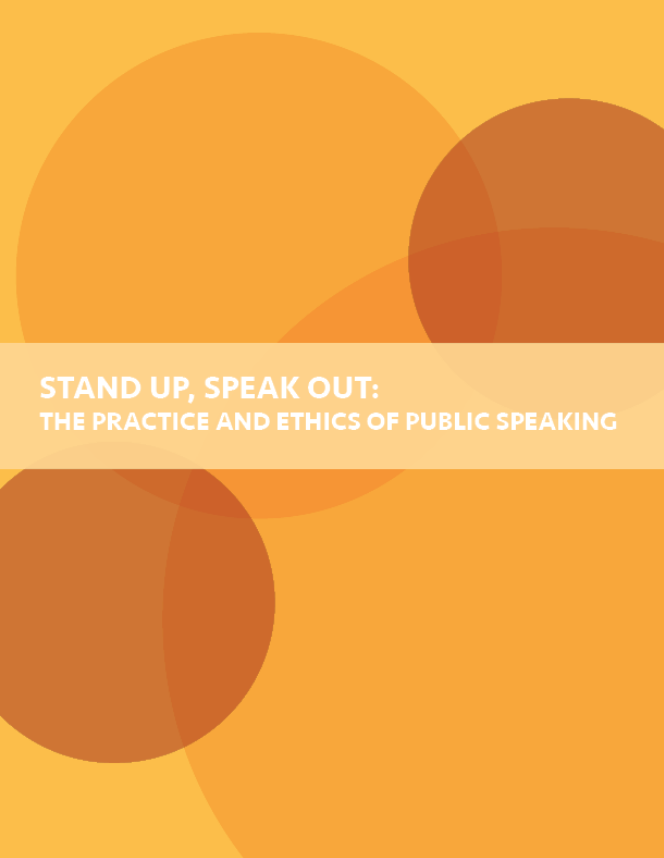Speaking Confidently Resources
Overview
If you’re like most people, the thought of giving a speech in front of a group of people probably makes you nervous, anxious, and perhaps even fearful. In fact, speaking in public is consistently ranked among people’s top fears, more so than flying, drowning, creepy-crawly critters, and zombies (Ingraham, 2014)! Understandably, public speaking can be challenging for even the most seasoned speaker, and there are many factors that go into communication apprehension (CA) and public speaking anxiety (PSA). This chapter will discuss some of the differences between communication apprehension, public speaking anxiety, glossophobia, as well as general social anxiety, along with the causes and symptoms of each. Additionally, this section offers some techniques for understanding and managing your fears or nervousness, while presenting exercises for reducing your speaking anxiety. This section also features resources that will help you build your confidence as a speaker, and teach you to present like a pro!
Learning Objectives
Upon completion of this section, students should be able to:
- Understand the types and causes of communication apprehension (CA)
- Understand the causes and symptoms of public speaking anxiety (PSA)
- Develop strategies for effectively managing CA/PSA
- Learn effective techniques for building speaking confidence
Recommended Textbook Resources
Stand up, Speak out: The Practice and Ethics of Public Speaking 
Chapter 3: Speaking Confidently (link)
3.1 What Is Communication Apprehension? (link)
3.2 All Anxiety Is Not the Same: Sources of
Communication Apprehension (link)
3.3 Reducing Communication Apprehension (link)
3.4 Coping with the Unexpected (link)
3.5 Chapter Exercises (link)
This chapter covers many of the most important aspects of speaking confidently. It aligns very closely (if not exactly) with the OCM/SLO for this section. It was selected by the team for its comprehensive topic coverage; clear, engaging language, thorough supporting sources from some of the leading scholars in the field; and of course, the publisher’s commitment to open educational resources.
Stand up, Speak out: The Practice and Ethics of Public Speaking 
Chapter 3: Speaking Confidently (link)
3.1 What Is Communication Apprehension? (link)
3.2 All Anxiety Is Not the Same: Sources of
Communication Apprehension (link)
3.3 Reducing Communication Apprehension (link)
3.4 Coping with the Unexpected (link)
3.5 Chapter Exercises (link)
This chapter covers many of the most important aspects of speaking confidently. It aligns very closely (if not exactly) with the OCM/SLO for this section. It was selected by the team for its comprehensive topic coverage; clear, engaging language, thorough supporting sources from some of the leading scholars in the field; and of course, the publisher’s commitment to open educational resources.
Supplemental Content/Alternative Resources
Personal Report of Public Speaking Anxiety (PRPSA)
http://www.jamescmccroskey.com/measures/prpsa.htm
This 34-question survey will help students understand their level of public speaking anxiety (and its causes) though a quantitative, numeric score (low, moderate, high). This page can be printed and completed manually by the student.
Personal Report of Communication Apprehension (PRCA-24)
http://www.jamescmccroskey.com/measures/prca24.htm
This instrument is a more broad measure of generalized communication apprehension, and includes questions pertaining to public speaking, interpersonal communication, as well as small and large group communication. This page can be printed and completed manually by the student.
For both instruments, it can be valuable if students complete the assessment during the first few days of class, and again near the end of the term. Students and instructors can compare scores and see if/how levels of anxiety changed after being exposed to various speaking situations, and after receiving feedback from an instructor and/or peers. Based on anecdotal evidence, end-of-semester PRPSA scores are typically 10-20% lower than those recorded earlier.
--
Helpful Videos:
No Freaking Speaking: Managing Public Speaking Anxiety
By: Matt Abrahams
https://www.youtube.com/watch?v=ZH5GpdMmIO8
Speaking Up Without Freaking Out
By: Matt Abrahams
https://www.youtube.com/watch?v=XIXvKKEQQJo
The 7 secrets of the greatest speakers in history
By: Richard Greene
https://www.youtube.com/watch?v=i0a61wFaF8A
The surprising secret to speaking with confidence
By: Caroline Goyder
https://www.youtube.com/watch?v=a2MR5XbJtXU
PowerPoint Slides

Copy to “My Google Drive”
https://docs.google.com/presentation/d/1sg5Z2uACzILUaJcsvvi6dF9yjSFsOMnlz4ad6Eq4XI4/copy
Force a download of PPTx File
https://docs.google.com/presentation/d/1sg5Z2uACzILUaJcsvvi6dF9yjSFsOMnlz4ad6Eq4XI4/export/pptx
Topic Application Section
Developing a strong, confident speaking persona is something that takes time and a LOT of practice. The following recommendations will help instructors coach students through managing public speaking anxiety, and will give students ample opportunities to desensitize themselves to the anxiety of the public speaking experience.
Small Speaking Exercises
Throughout the academic term, students should have as many opportunities as possible to practice getting up in front of an audience and delivering a speech. Instructors can develop small, low-stakes assignments that help relieve the pressure of grades, formality, and intimidating, complex speaking requirements.
For example, during the first week of class, students can deliver a short self-introductory speech that answers the following (or similar) questions:
Where were you born, and what is the story of your birth?
What is your favorite meal to either prepare or consume, and why?
Have you had your 15 minutes of fame? Tell us about it
If you were given $25,000, but couldn’t spend it on anything practical/necessary, what would you do?
Who is a role model in your life, and why?
What was your favorite or most memorable vacation/travel destination? OR, Where is somewhere you’ve always dreamed of traveling, and why?
Such a speaking assignment presents the student with a subject matter that they are familiar with, a short duration of time in front of their class, and a relatively informal, social delivery expectation. Speeches should be no more than 1 minute each, not require any presentation aids or citations, and should be graded on a very generous scale (i.e., full points for participation), though clear and actionable feedback should be given by the instructor.
Speech Workshops
Prior to each “major” speaking assignment in the class (e.g., the informative, persuasive, or performative speeches), instructors can offer a workshop session in which each student has the opportunity to present a short (no more than 30 sec.) part of their speech to their classmates. The expectation is that this is not a finished speech, but rather a first draft that will help the student further hone their writing, support, arguments, and delivery. Students are encouraged to try out their attention-getting devices or clinchers, or practice passages that include difficult words, numbers/data, or tricky delivery techniques like dynamic pacing, volume, or prosody.
Peers are encouraged to provide constructive feedback on the speaker’s workshop presentation. This encourages every student to develop a more critical approach to public speaking, while also helping them develop the language of speech critique.
The speech workshop assignment encourages students to be prepared in advance of their final presentations (a MAJOR boost in confidence) and also gives them yet another opportunity to practice a short, low-stakes presentation in front of an audience. Instructors should provide clear and actionable recommendations for each student, though, again, students should receive full points for participating in the workshop exercise.
Personal Report of Public Speaking Anxiety (PRPSA)
http://www.jamescmccroskey.com/measures/prpsa.htm
This 34-question survey will help students understand their level of public speaking anxiety (and its causes) though a quantitative, numeric score (low, moderate, high). This page can be printed and completed manually by the student.
It can be valuable if students complete the assessment during the first few days of class, and again near the end of the term. Students and instructors can compare scores (as a class, or in small groups) to see if/how levels of anxiety changed after being exposed to various speaking situations, and after receiving feedback from an instructor and/or peers. Based on anecdotal evidence, end-of-semester PRPSA scores are typically 10-20% lower than those recorded earlier.
End of Section Review
Topic Summary
This topic has addressed the factors that may prevent novice speakers from presenting confidently. Students read about the different types of communication apprehension (CA) (trait, audience, context, and situation), and how each may affect their preparation or performance. Further, social anxiety and public speaking anxiety were presented, along with tips for working with both in the speaking context (e.g., visualization, desensitization). Finally, through videos, textbook materials, and class activities, students were presented with several strategies for improving their confidence and poise as a public speaker.
Key Terms
- Communication apprehension (CA)
- Public speaking anxiety (PSA)
- Trait-based anxiety
- State-based anxiety / situational anxiety
- Contextual anxiety (formality, uncertainty, novelty)
- Audience-based anxiety (similarity, power relations, familiarity, size)
- Generalized social anxiety
- Fight or Flight response (psychological, physiological)
- Glossophobia
- Visualization
- Cognitive restructuring / Cognitive Behavioral Therapy (CBT)
- Self-talk (positive and negative)
- Systematic desensitization
- Audience analysis
- Four stages of speech delivery: anticipation, confrontation, adaptation, release
- Oral mode (vs. written)
Review Questions
- What are the differences between communication apprehension and public speaking anxiety. Similarities?
- Identify the four types of communication apprehension.
- What is the “fight or flight” response?
- What are the psychological or physiological reactions to CA and PSA?
- What can you do to manage CA during speech preparation?
- When delivering a speech, how can you minimize CA and improve your confidence?
Critical Thinking and Discussion Questions
- Identify strategies for managing each type of CA and describe how you might adjust your speech to overcome each.
- Identify a time when you experienced CA or PSA, and describe how you felt.
- What are some strategies that you have identified as helpful for reducing CA/PSA? What things have you tried that were not as effective? Did anything make your CA/PSA worse?
- Identify a speaker that you would like to emulate and describe how they use verbal and nonverbal communication to project confidence and poise. Can you identify organizing patterns or rhetorical devices that they use during the speech to help?
- Describe a time when something “went wrong” during a speech, and explain how it affected you or another speaker. (HINT: think of technical difficulties, loud noises, interruptions)